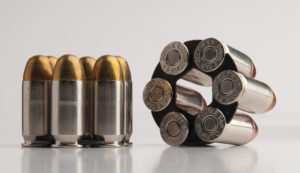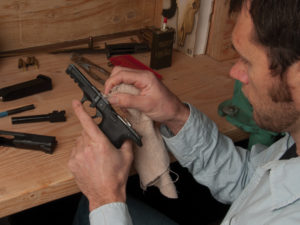By Joseph von Benedikt , Gun Digest
Semi-automatic handguns are typically the better choice for suburban and in-home use and, when cared for and kept clean, are the flavor of the day in what I’ll term combat zones—whether an Afghanistan outpost, a disaster area overrun by consequence-free crime, or an apocalyptic end-of-days scenario.
Revolvers, on the other hand, are the better option when sand, dust, and involuntary neglect add up to an environment that may challenge a semi-auto’s reliability. They are just more reliable in very dirty conditions. Also, revolvers tend to be chambered for more powerful cartridges—sometimes much more powerful—than semi-autos. While this is an advantage in the backcountry or around livestock and heavy predators, it’s a disadvantage in an urban neighborhood composed of thin walls and sleeping children.
Can the two vastly different handgun types cross over in usefulness? Absolutely. However, each has its strengths and weaknesses.
Revolvers
Since revolvers don’t depend on harnessing the energy of a cartridge to function, like semi-autos do, there’s just one less thing to go wrong. Squib loads, dud primers, a tight cartridge too stubborn to chamber easily—none of these affect revolvers. Additionally, since human muscle works a revolver’s action, bits of sand, lint, dust, or fouling that would choke a semi-auto can be overcome by, well, a little more muscle. Just ear that hammer back and let fly.
As mentioned earlier, the magnum cartridges frequently chambered in revolvers can offer quite an advantage for rural use, too. They provide more downrange reach, more downrange energy, and typically a great deal more penetration—important when scraping an enterprising black bear out of the bacon griddle next to your tent, or trying to kill a wigged-out saddle horse that’s running like a banshee while you bounce along the cactus-covered ground with your boot stuck in the stirrup.
Revolvers are slower to reload. With practice and a good speedloader (a device that holds the bases of a cylinder-worth of cartridges, and drops them into the open cylinder of a double-action revolver at the twist of a knob) or moon clip (a spring steel device that holds a cylinder-full of cartridges, and goes into and out of the gun with them), a good revolver man can get back into action pretty quickly. But, speedloaders and moon clips are awkward to carry, and it takes good training to achieve speed and surety. Single-action revolvers are even slower. Much slower.
On the plus side, your revolver will never turn into a one-shooter because you misplace your magazines. And if you’ve got a little survivalist in your nature, you’ll appreciate the fact that empty cartridge brass is easy to collect—just dump it into your pocket after ejecting it. With care, you’ll never loose a piece, and you never have to hunt for little sparkly brass bits flung indiscriminately away by your greedy semi-auto.

Some revolvers are cut for moon clips such as those shown here. With practice a good shooter can reload as quickly as a semi-auto shooter. But moon clips are awkward to carry.
–
Revolvers have the appealing virtue of simplicity. Neophyte shooters intuitively grasp how they function, and the lack of slides, slide stops, magazine releases, decockers, and safeties of various flavors is attractive. Many women opt to carry a compact revolver for that winsome simplicity, frequently compounded by the fact that petite women sometimes struggle to pull back a semi-auto pistol’s slide in order to chamber a cartridge.
As I see it, the revolver has only a few drawbacks as a prime personal protection sidearm. They have limited capacity, they are slow to reload, and the cartridges for which they are chambered are often overpowered for city and in-home use.
The first two drawbacks are what they are, and shooters opting for a revolver should plan on spending time practicing reloading in order to even the odds a bit. The over-power issue, on the other hand, can be turned to the owner’s benefit by choosing ammunition with hollow-point projectiles designed for dramatic expansion, in a light-for-caliber weight. The effect is two-fold: With less mass, projectiles will penetrate less, and the large, on-impact expansion will slow bullets down, dumping more energy into the bad guy and reducing the chance of a pass-through that could potentially endanger family members or neighbors.
It boils down to this: With the correct ammunition and some quality practice-time manipulating the gun, a revolver will do anything you’ll ever need it to.
Semi-automatics

Semi-autos are often the best choice for personal and home protection. Just be sure you get one you can operate comfortably—many shooters with low hand strength struggle to function the slide of a big semi-auto, especially under stress.
–
As far and away the most popular type of sidearm for personal protection, the semi-auto’s primary attractions are high capacity and excellent rapid-fire capability. With correct maintenance and quality ammunition, good semi-autos are very reliable, too.
I grew up carrying a revolver while working cattle in Southwestern desert country. None of the guys I knew owned a semi-auto because prevailing opinion was that they couldn’t cut the mustard in the country and conditions in which we worked. I’ve since learned differently—a good semi-auto can take an awful lot of abuse and still function reliably.
When I first started carrying a semi-auto (a Colt Gold Cup 1911 in .45 ACP) it wasn’t for high capacity, it was for the rapid-fire characteristic. The Colt didn’t really offer much in the way of additional round count—my surplus G.I. magazines were seven-rounders. Heck, my single-action .44-40s held six. But I couldn’t shoot a single-action as quickly as a semi-auto, and though I could hose rounds downrange pretty quickly out of a double-action, I couldn’t shoot it fast nearly as accurately as my 1911.
Speed is one of the most important advantages that a semi-auto offers the average person. Sure, there are revolver shooters who can shoot faster and more accurately than 99 percent of the semi-auto shooters out there, but the reality is that, for most folks, semi-autos are a little easier to shoot fast than revolvers.
Throw in high capacity, and you’ve got a very supportable argument that the semi-auto makes a better personal protection gun than does a revolver. Truth is, most of today’s popular designs hold more cartridges than a wheelgun—usually a lot more. Even a modern magazine in a .45-caliber 1911 holds eight rounds, plus one in the chamber. That’s a total of nine, for a 50-percent increase on the capacity of most revolvers. Throw in high-capacity guns, such as Glock’s G17, Smith & Wesson’s M&P9, and Springfield’s XD(m), all of which contain 17+1 to 19+1 rounds in the magazine, and you’ve got three times the capacity of a revolver. Three times! Add a couple of easy-to-carry magazines in innocent-looking belt sheaths, and you can comfortably carry over 50 rounds on your person.
You can argue that, in most of today’s typical defensive encounters, you shouldn’t need even a tenth that number. You’d be right. However, what about that non-typical encounter? Or—admit it, we all think about it—an end-of-days scenario? There are a lot of situations in which it would be mighty comforting to have 50-plus rounds available.
Semi-autos do have some drawbacks. They are clean freaks. They are also picky about subpar ammo. Whereas a revolver will accept anything that fits properly into a cylinder chamber and will dutifully fire it downrange, a semi-auto must have cartridges with the correct bullet nose geometry for reliable feeding, enough propellant to fully function the slide but not so much that it batters the internal mechanics, correct case length for proper headspacing… all this within spec so that it flows into the chamber and out again without hanging up in a gun powered purely by energy harnessed from the explosion of the cartridge itself. Looked at from an informed, objective position, that’s a lot to ask. It’s a marvel than so many semi-autos are the reliability champs that they are.

Most semi-autos are clean freaks. Treat them with care, and they will always take care of you.
–
The very magazines that provide high-capacity firepower can—if lost or damaged—cripple a semi-auto and, in essence, turn it into a single-shot. Or worse, incapacitate it completely if it’s one of the models with a magazine disconnect safety that prevents it from firing unless a magazine is inserted. These days, we take magazines pretty lightly, as most of us have a spare or several. But in the early days of semi-autos, folks considered the potential more gravely. Many early models—especially those of European design—didn’t allow magazines to fall freely when released; this influence extended up through the first-generation Glocks.
Limited energy and penetration are another characteristic of shots fired from most semi-auto handguns. In many scenarios, limited penetration is an advantage. A 9mm hollow-point projectile is much less likely to penetrate through walls than a classic soft-point .357 Magnum projectile. But it does limit a semi-auto’s suitability for certain tasks. I know of two Alaskan bear guides who carry semi-auto .45 ACP pistols for backup. What tomfoolery. Even the more powerful revolver calibers (until you get to the obscenely powerful .500 S&W Magnum) are unsuitable for stopping a bear with uncivilized intentions, let alone a semi-auto with very limited penetration and (in bear terms) not nearly enough energy on impact.
However, we’re discussing personal protection firearms here, and none of the above semi-auto drawbacks really apply. Shoot quality ammunition, and purchase plenty of magazines and keep track of them diligently. As long as you attend to those two details, a good semi-auto makes more sense than a revolver most of the time.
—–
This article is an excerpt from Firearms for Personal Protection
Armed Defense for the New Gun Owner
By Joseph von Benedikt – Click Here to get a copy.
Thanks to Gun Digest for this post. Click here to visit GunDigest.com.
Take the time to check out the Free Gun Digest Downloads – Click here to see this free resource.












